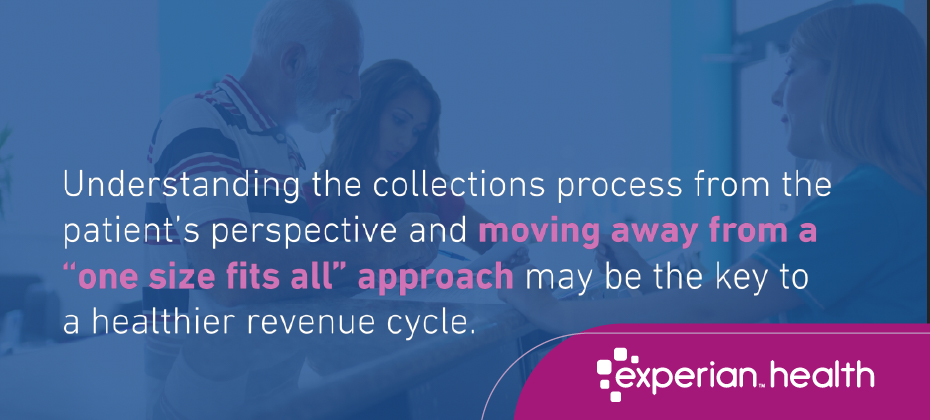Tag: Collections Optimization Manager

With high-deductible health plans, larger out of pocket costs, and confusion about medical costs in general, it’s no surprise that patients today face increased financial responsibility. Unfortunately, the current pandemic has introduced an entirely new level of financial responsibility and uncertainty for both patients and providers. Like many provider organizations across the country, Yale New Haven Health was feeling the impact of the changing healthcare landscape. Patients are finding it harder and harder to pay their medical bills, and more accounts are going to debt. The organization obviously needed to be compensated for their services and improve collections, but it needed to do so in a way that matched its mission and vision of providing high value, patient-centered care. A few years ago, Yale New Haven Health turned to Experian Health to improve collections with an elevated patient experience. With Experian Health’s Collections Optimization Manager, Yale New Haven Health was able to score and segment patient accounts based on who has the propensity to pay, determine how a patient could best resolve their bill and then direct them to the appropriate resources for doing so. The organization supplemented this activity with PatientDial, a cloud-based dialing platform that offers inbound and outbound communication options to increase collections. While these efforts have improved collections for the organization in the past, they have proven invaluable for both the revenue cycle and the patient experience during COVID-19. Increased patient satisfaction. A billing indicator was included for patients that might be experiencing financial hardship as a result of COVID-19, allowing the organization to hold that particular billing statement for 90 days. After 90 days, those accounts were again reviewed and evaluated for charity care as necessary. Patients have been grateful for the extra time and flexibility for payment during such a stressful event. Continued collections. With these steps in place, Yale New Haven Health was able to maintain the regular daily statement production and movement of accounts through the revenue cycle for those not experiencing COVID-related hardship. The additional revenue supported the institution and helped to maintain collection levels as close to normal as possible during uncertain times. Improved communications. Even with the 90-day delay for select accounts, call campaigns with PatientDial continued throughout the pandemic. Connection rates have increased by 5.5% month over month from January to present. Patients are not only pleased with the communications over balances due but are more receptive to attempts to resolve debt as the organization has approached billing-related communications in a more empathetic manner.

While all hospitals and health systems will no doubt encounter revenue-specific challenges related to the pandemic, a solid foundation and targeted approach for improved collections can help speed up the road to recovery. In fact, it was Sanford Health’s unique approach to increasing patient collections that allowed it to both optimize collections during the pandemic and improve employee satisfaction and retention. Several years prior to COVID-19, Sanford took steps to improve collections with a patient-focused, hybrid approach that combines employee incentives with segmentation strategies. Leveraging Collections Optimization Manager and PatientDial from Experian Health, Sanford was able to quickly and easily streamline call center operations and increase collections in a myriad of ways – through new and updated patient addresses, patient-friendly billing statements, identifying new guarantors and more. With the above items in place, Sanford was already well positioned to seamlessly manage normal business operations during a pandemic. The organization was able to quickly adapt, and then build on that momentum to better serve its patients and staff, while also driving results. Since the start of COVID-19, Sanford has: Increased employee satisfaction with remote capabilities PatientDial allowed Sanford to seamlessly transition its call center team to work remote. Where about 30% of the workforce was remote prior to COVID-19, just shy of 99% of call center representatives are now remote. This has been a great source of employee satisfaction and safety and has aided in the system’s ability to keep the collections momentum going. Provided a more compassionate approach to collections Recognizing that this is a sensitive time for many, Sanford ensured the proper mechanisms were in place to identify those who required additional help, offering the best methods for collection possible. Sanford has not only created a billing indicator for patients affected by COVID-19, but Experian Health has provided additional insight with a weekly file of patients who are identified as possibly financially stressed. Improved collections during time of crisis While collections decreased for the quarter, Sanford saw a record increase in collections for the month of March -- $800K more than the system saw in March of 2019.

Before working with Experian Health, call center operations at Sanford Health were disparate and disjointed, with each call center operating on a different phone system with different carriers. While some centers saw high abandonment rates, others were waiting around for calls. Although Sanford attempted to create balance by placing accounts in a work queue, the process for managing outbound collection calls remained manual and it was impossible to identify and strategically contact patients based on ability to pay. Sanford took steps to improve collections with a patient-focused, hybrid approach that combines employee incentives with segmentation strategies. Since working with Experian Health, Sanford now has a focused approach to managing accounts receivable (AR) by identifying patients with a certain propensity to pay. Collections Optimization Manager allows Sanford to quickly identify a pathway and delivery to resolution of the patient’s balance. The analytical segmentation models within Collections Optimization Manager use precise algorithms that reveal those patients who likely are eligible for charity services, those who might prefer to pay in full at a discount, or those who might benefit from a payment plan. The solution then feeds segmentation data to PatientDial, which Sanford uses to route calls to 70 patient account representatives. Sanford also implemented a re-designed, more user-friendly patient statement format. The improved cover page offers easy-to-understand information about the bill including the available options for payment. In a larger effort to improve the patient experience, Sanford implemented an employee incentive program that appropriately rewards staff based on their collections’ performance. Since working with Experian Health, Sanford has seen the following improvements: Streamlined call center operations. With PatientDial in place, Sanford was able to consolidate its call center team members in 4 regions and seamlessly operate on centralized toll free and direct dial numbers. Where it used to take on average 56 seconds for a call to be answered, calls are now answered in 20 seconds or less. The system now comfortably manages an average of 12,000 inbound calls weekly. Increased collections. The model in place has allowed Sanford to improve collections in a myriad of ways. In addition to increased collections from calls made through PatientDial, Sanford was able to see an additional $2.5M in patient payments by ensuring patient statements were sent to the new or correct address. The system found an additional $60K by identifying new guarantors for accounts of deceased patients. The segmentation capabilities from Experian Health also enabled Sanford to identify patients struggling with bankruptcy, allowing staff to focus their efforts on collectible accounts and more efficiently direct individuals to charity options. Learn more about Sanford Health’s journey and how a similar approach could help your organization improve collections and employee satisfaction.

When it comes to paying for healthcare, “compassionate” is probably not the first word that comes to mind for patients. As they foot a greater portion of medical expenses, it’s often an experience rife with stress and uncertainty. Providers try to give accurate price estimates, but when patients switch coverage plans or payers change their policies, it’s difficult to be sure the original estimate matches the final bill. And what if a patient simply can’t afford to pay? When 56% of consumers say they would not be able to pay an unexpected bill over $1000, this not only indicates a tough ride for patients, but points to why so many providers are struggling to collect in full – around two-thirds of patient balances over $200 go uncollected. It’s unsurprising, then, that more healthcare organizations are looking at ways to create a better financial experience for patients. Understanding the collections process from the patient’s perspective and moving away from a “one size fits all” approach may be the key to a healthier revenue cycle. Could a more compassionate approach to billing help patients meet their financial obligations? How providers are turning to compassionate billing to help patients and improve revenue Thanks to advances in data analytics and technology, providers have a host of tools at their disposal to improve the patient financial experience. The following three strategies are generating some great results for providers: 1. Use data to give patients the right payment options A common pitfall across healthcare billing is to treat every patient the same. But sending a bill and hoping it gets paid is clearly not a reliable collections strategy. A compassionate billing approach means you look at each patient’s current financial situation and consider their ability and likelihood to pay. With the rich data analytics now available, you’ll know whether a simple statement will be enough to prompt payment from the patient, or whether a little extra handholding will be needed. Are there other payment plans that might be more appropriate? Would they benefit from a call or text to remind them of the next task they need to complete? Data analytics let you tailor the process so you can help your patients pay their bills in the way that suits them best, including finding missing coverage. Novant Health used Collections Optimization Manager to automate and increase patient collections. With this solution, Novant Health saw a 5.8% increase in unit yield year-over-year, and an overall recovery rate of 6.5%. Overall increased revenue and cost savings amount to an impressive rolling average return on investment – 8.5:1. 2. Personalize the way you communicate with patients Data analytics don’t just help you offer payment plans based on the individual, they allow you to determine a patient’s preferred method of communication. Do they prefer to get a statement in the mail or via email? Are there particular communication messages that will resonate with different patient groups? Paying bills can be a sensitive topic, especially if someone is struggling financially. Being able to create personalized messages at each touch point in the process is a helpful way to build compassion and consumer trust into the financial experience, so patients are more likely to engage with the process. The University of California San Diego transformed their patient financial experience by using Collections Optimization Manager to segment patients, as part of a broader exercise to improve collections. Knowing more about individual patients’ circumstances meant they could offer more relevant communications and build a more sensitive patient engagement strategy. 3. Make it convenient and easy to pay Every patient will thank you for a quick and painless payment process. Offering flexible payment options including online, in person and phone is critical. According to Kyle Wilcox of Grinnell Regional Medical Center, this is all about the ‘golden rule’ of patient payments: treating patients as you would want to be treated. He says: “At GRMC, we provide consumers with a range of choices to make payments, such as in person, by mail, electronically online or via mobile technology, and by cash, credit or debit card. Doing so allows them to pay in a way that is most convenient for them, improving their satisfaction and the hospital’s likelihood of receiving payment.” What’s more, efficient payment tools can improve your staff workflows too, giving them more time to help patients who need extra assistance and reducing the cost to collect. Heather Grover, Vice President of Product Management for Patient Collections, Experian Health, said: “We had a small community-based hospital use Collections Optimization Manager product with PatientDial. On average, the cost to collect for many of our clients is anywhere between 7% and 15%. They saw theirs decline to 5% and over a two-year period, their cash collections increased to 42% prior.” Ultimately, there are some patients who can pay and some who can’t. It’s a sensitive topic to navigate, but when patients feel supported, they’re more likely to be able to meet their financial obligations. Collections Optimization Manager lets you figure out who’s who and offer them the most appropriate support to get their healthcare bills paid, so they can get on with life.

Chalk it up to the rise of high-deductible plans or decreasing payer reimbursements, but the numbers don’t lie: patients are footing more of their healthcare bills and hospitals are struggling to collect. In fact, a recent TripleTree report revealed there has been a 69 percent increase in consumer payments due to providers over the past four years. That same report also noted providers collect only 1/3 of patient balances larger than $200, with the balance being sent to collections or written off as bad debt. All this to say … collections can make or break a hospital. So, how are hospitals compromising on their collections game? Let us count the ways: 1. They treat all patients the same. Some patients may be able to cover all their care costs up front, while others need to spread out payments, or perhaps get help from a lender or charity. Logical, right? But for some reason, many hospitals take a one-size-fits-all-approach to their collections work. They’ll simply submit the bill, wait for payment and see what happens. If payment fails to come in after repeated attempts, they send the account to collections, and the agency often takes a similar approach. Scoring and segmenting patient accounts based on who has the propensity to pay –and directing them to the in-house or outsourced team most likely to collect – is a much more productive collections strategy. Even better, providers should try to determine what patients owe before a procedure, and reveal payment plan options from the start. By developing a means to estimate the cost of a patient's care, providers can deliver a figure to target for pre-operative, pre-procedure collection. 2. They lack an agency strategy. Just as hospitals can take one-size-fits-all approach with their patient collections, so too can be the case with their collections agencies. Some hospitals find themselves struggling with how to reconcile accounts placed with their agencies. Others are unhappy with their early- or late-stage collections vendor, but can’t quite pinpoint where it’s all going wrong. Advocate Aurora Healthcare, an operation with 27 hospitals and 500 outpatient locations, was trying to oversee 20 different collections agencies just a few years ago. They wanted to reduce the number of agencies doing their collections work, and gain a clearer understanding of who was performing best, but they lacked the data insights to evaluate. By tapping into a collections optimization platform, Advocate Aurora was able to reduce their agencies from 20 to four, and they started seeing double-digit increases in their patient collections. Routing accounts to the optimal collections resources, and using collection agencies judiciously, minimized their collection costs, and helped them stay focused on patients who can and will pay. 3. They rely on limited data sources. To create a truly effective collections strategy that is both predictive and insightful, hospitals need to rely on data sources that offer breadth and depth. Let’s consider an example. In the credit world, financial services companies can be looking at two consumers with identical credit scores and come to the conclusion that they should treat each the same. But with more data insights, a lender might see that one is trending up, making on-time payments that exceed the minimum balance, and the other is trending down, showing signs of payment distress. With historical data and other insights, the financial lender would likely treat each of those individuals differently. Agree? The same scenario can unfold in the healthcare space. If providers are solely looking at zip code data, or historical healthcare data, they will be challenged to offer personalized payment plans and decisions around how best to collect. Combining various data sources, including credit data, can provide hospitals with deeper insights into a patient’s propensity to pay and financial disposition. This allows healthcare organizations to identify the best financial pathway for each patient at, or before, the time of service, and will ultimately optimize their account receivable performance as well. --- By flipping the switch on a few of these strategies, hospitals can turn their patient collections game around. They’ll see gains in patient satisfaction, improvement in the accounts receivable bucket and the power data can have on segmentation. There’s really no excuse to fail.

Sanford Health vetted four revenue cycle vendors to meet their challenges of manual collection processes, bad debt and low employee collection rates. They selected Experian Health largely based on ease of implementation with the Epic platform, products that required little intervention from Sanford’s IT department, a strong team of consulting resources and previous success with other Experian Health products. According to Mike Beyer, Director Patient Accounts, Sanford Health, “Collections Optimization Manager really allows me to segment out and find those patients that have the ability to pay; and to avoid chasing those who instead qualify for our Presumptive Financial Assistance/Charity program.” With Collections Optimization Manager, Sanford Health realized a total in-house patient collection lift of $40+ million since they first implemented in October 2014; with an average monthly lift is $2.3 million. Contributing drivers of this success: leveraging segmentation and Federal Poverty Level (FPL) within Collections Optimization Manager to determine Presumptive Financial Assistance and account routing to our new cloud-based dialer solution, PatientDial. Download the full case study Watch the video